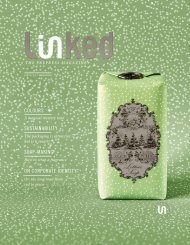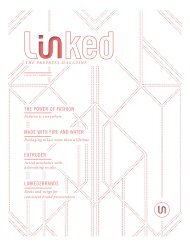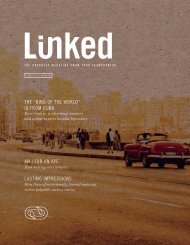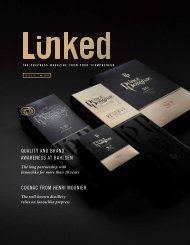Janoschka magazine Linked_V6_2021
Create successful ePaper yourself
Turn your PDF publications into a flip-book with our unique Google optimized e-Paper software.
26
f a c e t o f a c e
issue #6 ©
l i n k e d
27
“Ethiopian coffee traditionally has
a heavy, earthy taste. Here, it is the
custom to serve coffee with a little sprig
of rue. When I stir the coffee with this
herb, it acquires a bright aroma with
fruity notes of bramble and raspberry.”
Daniel Tesfaye leans back against the
Grounds for
Celebration
colourful hangings covering the wall
of the little street café in Addis Ababa,
a look of satisfaction on his face. The
smell of the coffee just roasted on a
little brazier fills the narrow room. A
wooden mortar to grind the coffee in
and a traditional clay pot called a jebena
– that’s all this corner café needs
to prepare coffee.
The “black gold” is served in small,
Mysterious and Dark:
The Culture That Became a Cult
Thirteen months sunshine a year –
perfect conditions to produce perfect coffee.
But hang on a moment... thirteen months?
What might sound like a marketing ploy is
measurable reality in Ethiopia.
In the birthplace of coffee, not only do the
clocks run differently, life also follows a
completely different calendar.
The year begins on 11 September, and the
last month of the year is only a few days long.
That’s how Ethiopians get thirteen months
of sunshine – much to the benefit of the
country’s world-famous export.
“coffee has to be as hot
as hell, black as the
devil, pure as an angel,
sweet as love.”
With between 800 and 1,000 different
aromas, coffee is a taste
explosion and far more complex
than wine. Coffee testers, or cuppers
as they’re called, distinguish
between earthy, mild and strong;
between sweet, nutty, chocolatey
and fruity aromas; and between
coffees that taste of honey, flowers,
pepper, bread or caramel. It
takes a great deal of experience
to be able to identify the fine and
complex nuances and to describe
and evaluate the coffee.
In Ethiopia, flavours range from
the idiosyncratic, mysterious and
ambiguous taste of Harrar beans
to the elegant, bright aromas that
envelop the Sidamo and Limu coffees
pervaded by floral notes.
But the quintessential Ethiopian
coffees come from Yirgacheffe.
With their shimmering, extravagant,
spicy, lemony aromas, these
full-bodied, eclectic and balanced
coffees are simply unmistakeable,
the expert reveals.
demi-cups typical of Ethiopia. Here, in
the capital of this East African country,
a culture is emerging based on a coffee
tradition dating back thousands of
years that can certainly rival any of the
world’s hippest coffee centres. Daniel
Tesfaye is part of this culture. As a professional
coffee taster, he samples up
to 500 cups of coffee a day, evaluating
and grading the quality, the taste and
the aroma.
Charles-Maurice de Talleyrand
(18th century)









